ASS065-1 Skills for Social Sciences: Academic Writing and Research
VerifiedAdded on 2023/05/30
|11
|2847
|210
Portfolio
AI Summary
This portfolio assignment for the Skills for Social Sciences course (ASS065-1) consists of two parts. The first part is a reflective piece on academic writing styles (descriptive, analytical, persuasive, and critical) and their importance in higher education, followed by an introduction to the chosen research topic: mental health. The second part demonstrates an understanding of how research is used for social enquiry, focusing on mental health as a public health concern and its relationship to social problems like juvenile delinquency. The assignment discusses the prevalence of mental health disorders, factors contributing to them, and potential interventions, emphasizing the importance of early intervention and family support in addressing mental health issues and preventing negative social outcomes. Desklib provides access to similar solved assignments and resources for students.
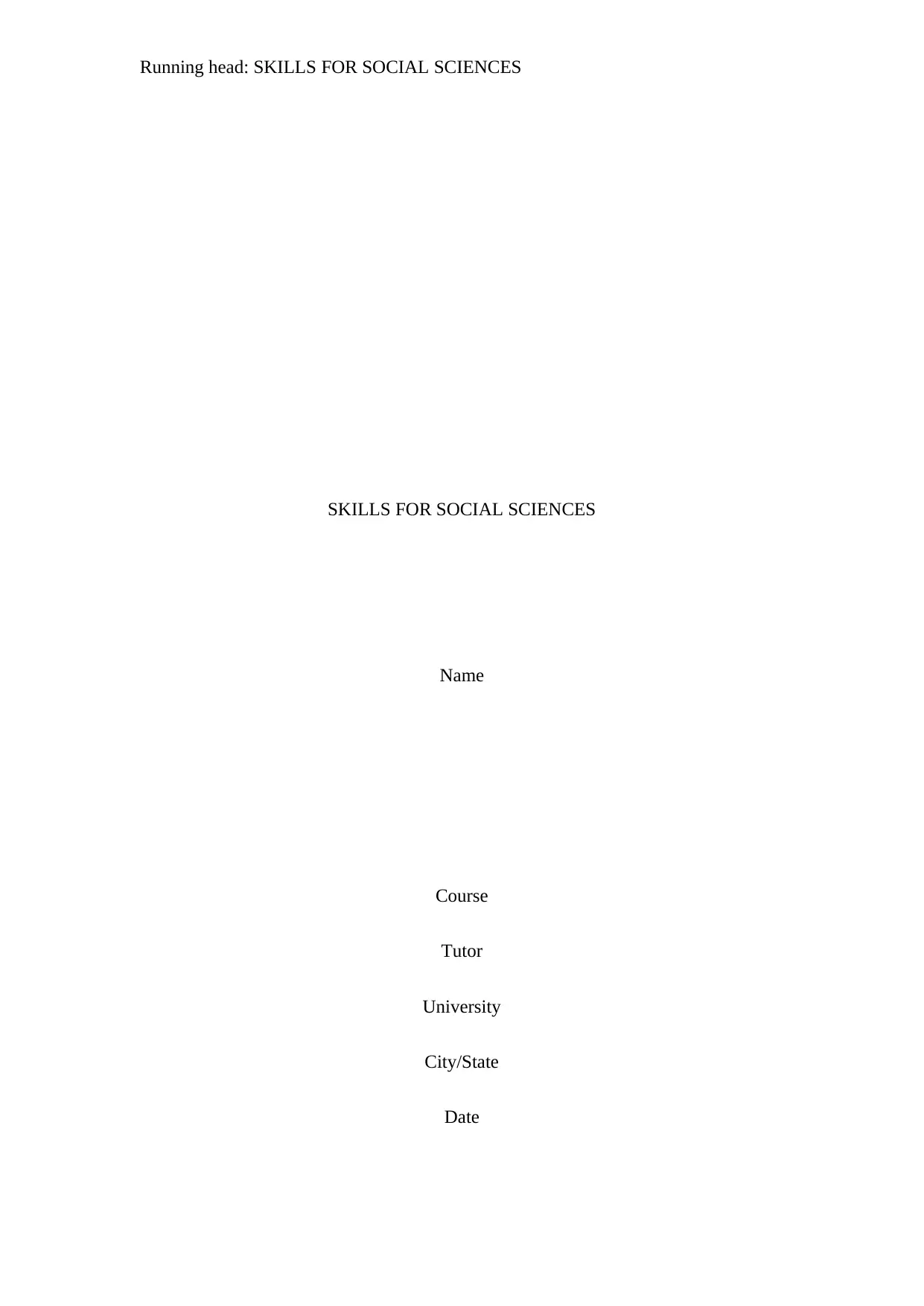
Running head: SKILLS FOR SOCIAL SCIENCES
SKILLS FOR SOCIAL SCIENCES
Name
Course
Tutor
University
City/State
Date
SKILLS FOR SOCIAL SCIENCES
Name
Course
Tutor
University
City/State
Date
Paraphrase This Document
Need a fresh take? Get an instant paraphrase of this document with our AI Paraphraser
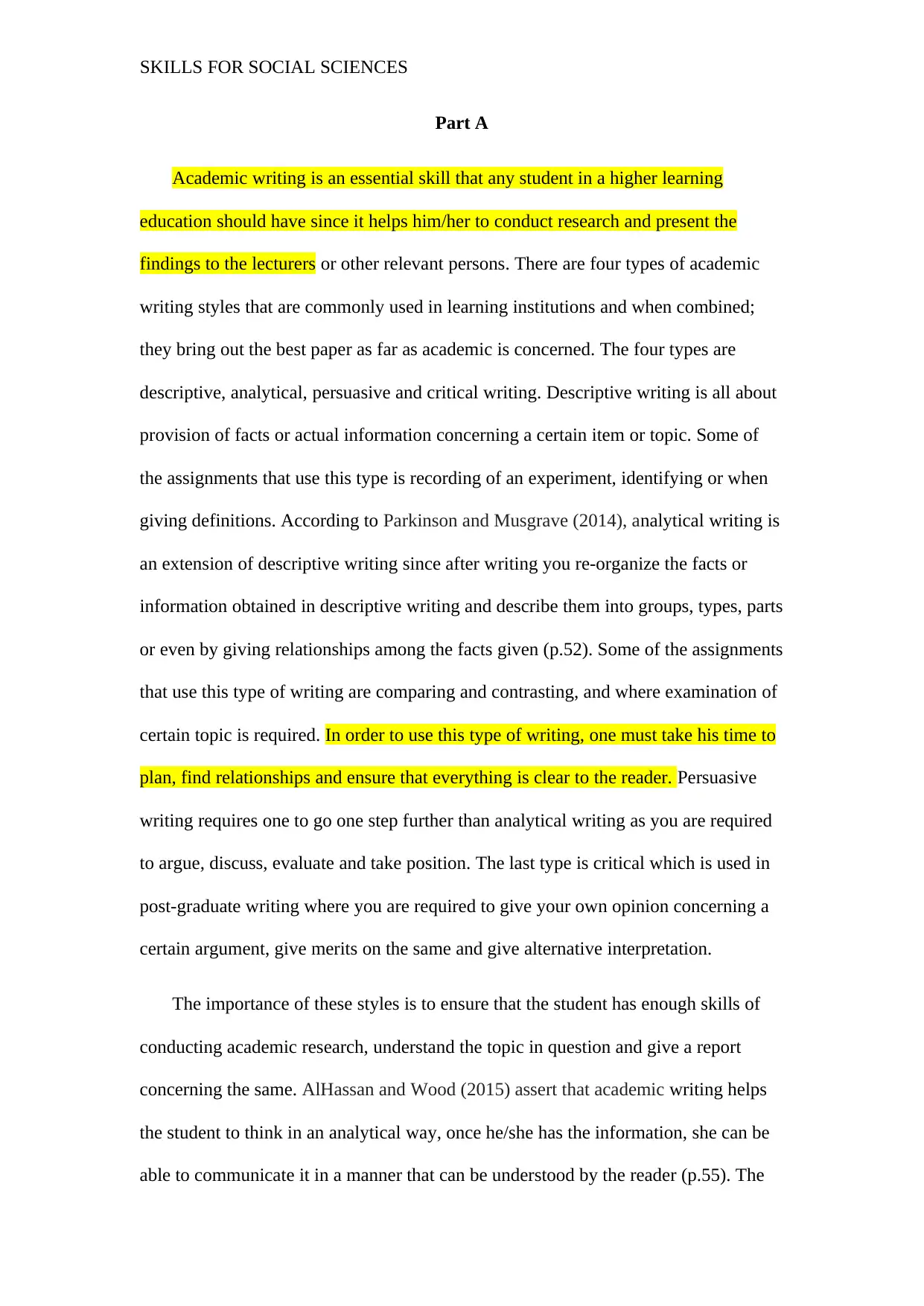
SKILLS FOR SOCIAL SCIENCES
Part A
Academic writing is an essential skill that any student in a higher learning
education should have since it helps him/her to conduct research and present the
findings to the lecturers or other relevant persons. There are four types of academic
writing styles that are commonly used in learning institutions and when combined;
they bring out the best paper as far as academic is concerned. The four types are
descriptive, analytical, persuasive and critical writing. Descriptive writing is all about
provision of facts or actual information concerning a certain item or topic. Some of
the assignments that use this type is recording of an experiment, identifying or when
giving definitions. According to Parkinson and Musgrave (2014), analytical writing is
an extension of descriptive writing since after writing you re-organize the facts or
information obtained in descriptive writing and describe them into groups, types, parts
or even by giving relationships among the facts given (p.52). Some of the assignments
that use this type of writing are comparing and contrasting, and where examination of
certain topic is required. In order to use this type of writing, one must take his time to
plan, find relationships and ensure that everything is clear to the reader. Persuasive
writing requires one to go one step further than analytical writing as you are required
to argue, discuss, evaluate and take position. The last type is critical which is used in
post-graduate writing where you are required to give your own opinion concerning a
certain argument, give merits on the same and give alternative interpretation.
The importance of these styles is to ensure that the student has enough skills of
conducting academic research, understand the topic in question and give a report
concerning the same. AlHassan and Wood (2015) assert that academic writing helps
the student to think in an analytical way, once he/she has the information, she can be
able to communicate it in a manner that can be understood by the reader (p.55). The
Part A
Academic writing is an essential skill that any student in a higher learning
education should have since it helps him/her to conduct research and present the
findings to the lecturers or other relevant persons. There are four types of academic
writing styles that are commonly used in learning institutions and when combined;
they bring out the best paper as far as academic is concerned. The four types are
descriptive, analytical, persuasive and critical writing. Descriptive writing is all about
provision of facts or actual information concerning a certain item or topic. Some of
the assignments that use this type is recording of an experiment, identifying or when
giving definitions. According to Parkinson and Musgrave (2014), analytical writing is
an extension of descriptive writing since after writing you re-organize the facts or
information obtained in descriptive writing and describe them into groups, types, parts
or even by giving relationships among the facts given (p.52). Some of the assignments
that use this type of writing are comparing and contrasting, and where examination of
certain topic is required. In order to use this type of writing, one must take his time to
plan, find relationships and ensure that everything is clear to the reader. Persuasive
writing requires one to go one step further than analytical writing as you are required
to argue, discuss, evaluate and take position. The last type is critical which is used in
post-graduate writing where you are required to give your own opinion concerning a
certain argument, give merits on the same and give alternative interpretation.
The importance of these styles is to ensure that the student has enough skills of
conducting academic research, understand the topic in question and give a report
concerning the same. AlHassan and Wood (2015) assert that academic writing helps
the student to think in an analytical way, once he/she has the information, she can be
able to communicate it in a manner that can be understood by the reader (p.55). The
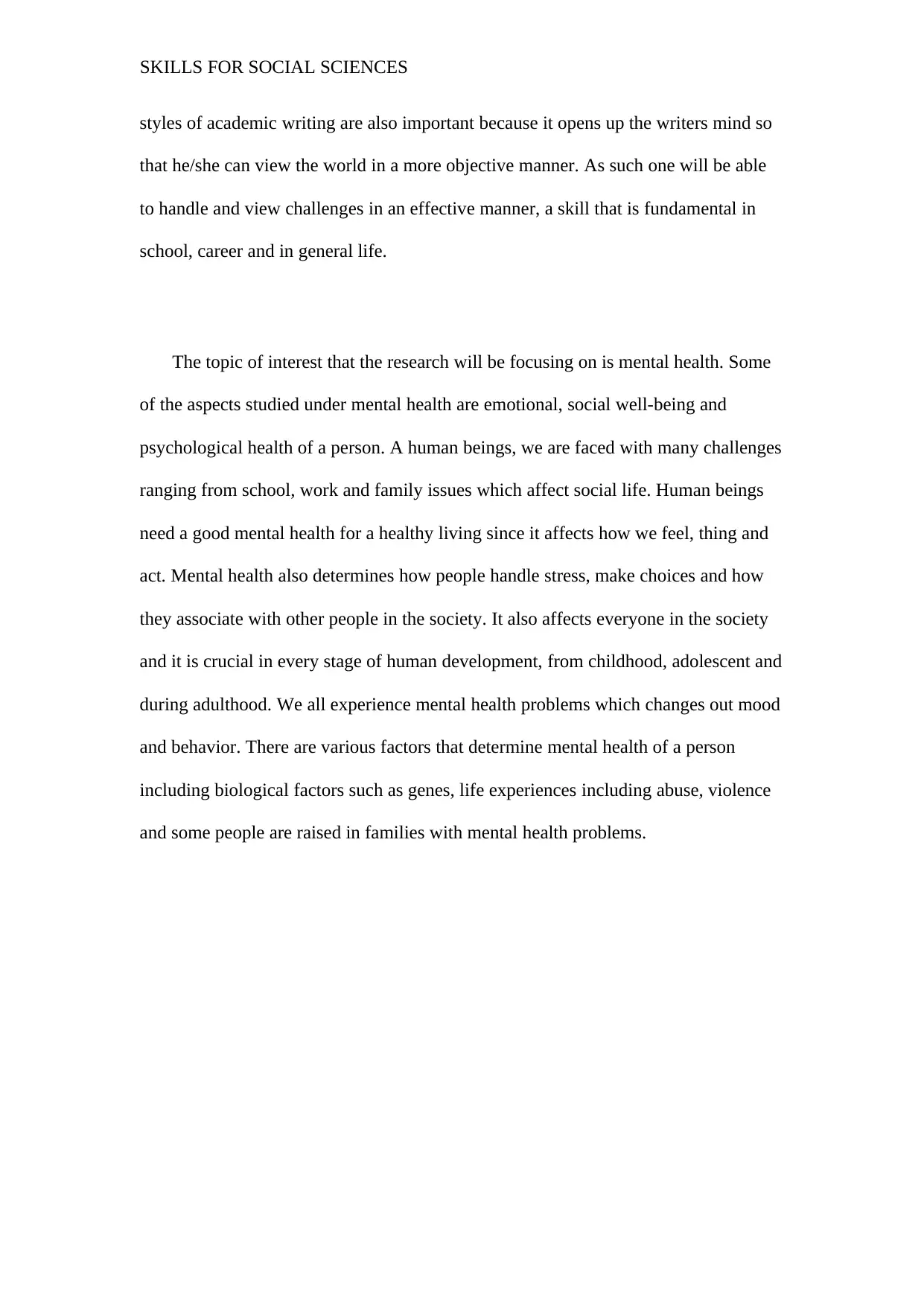
SKILLS FOR SOCIAL SCIENCES
styles of academic writing are also important because it opens up the writers mind so
that he/she can view the world in a more objective manner. As such one will be able
to handle and view challenges in an effective manner, a skill that is fundamental in
school, career and in general life.
The topic of interest that the research will be focusing on is mental health. Some
of the aspects studied under mental health are emotional, social well-being and
psychological health of a person. A human beings, we are faced with many challenges
ranging from school, work and family issues which affect social life. Human beings
need a good mental health for a healthy living since it affects how we feel, thing and
act. Mental health also determines how people handle stress, make choices and how
they associate with other people in the society. It also affects everyone in the society
and it is crucial in every stage of human development, from childhood, adolescent and
during adulthood. We all experience mental health problems which changes out mood
and behavior. There are various factors that determine mental health of a person
including biological factors such as genes, life experiences including abuse, violence
and some people are raised in families with mental health problems.
styles of academic writing are also important because it opens up the writers mind so
that he/she can view the world in a more objective manner. As such one will be able
to handle and view challenges in an effective manner, a skill that is fundamental in
school, career and in general life.
The topic of interest that the research will be focusing on is mental health. Some
of the aspects studied under mental health are emotional, social well-being and
psychological health of a person. A human beings, we are faced with many challenges
ranging from school, work and family issues which affect social life. Human beings
need a good mental health for a healthy living since it affects how we feel, thing and
act. Mental health also determines how people handle stress, make choices and how
they associate with other people in the society. It also affects everyone in the society
and it is crucial in every stage of human development, from childhood, adolescent and
during adulthood. We all experience mental health problems which changes out mood
and behavior. There are various factors that determine mental health of a person
including biological factors such as genes, life experiences including abuse, violence
and some people are raised in families with mental health problems.
⊘ This is a preview!⊘
Do you want full access?
Subscribe today to unlock all pages.

Trusted by 1+ million students worldwide
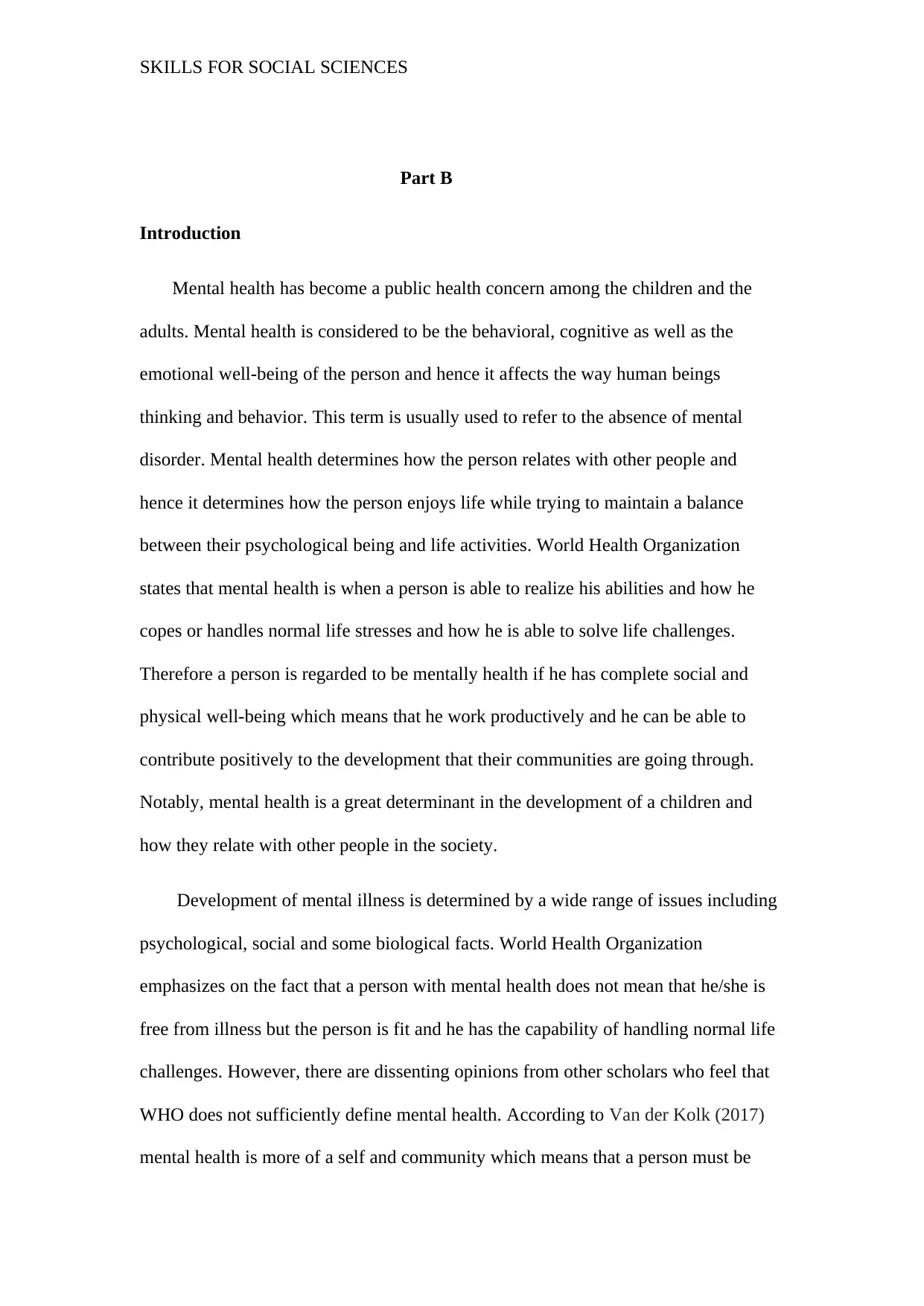
SKILLS FOR SOCIAL SCIENCES
Part B
Introduction
Mental health has become a public health concern among the children and the
adults. Mental health is considered to be the behavioral, cognitive as well as the
emotional well-being of the person and hence it affects the way human beings
thinking and behavior. This term is usually used to refer to the absence of mental
disorder. Mental health determines how the person relates with other people and
hence it determines how the person enjoys life while trying to maintain a balance
between their psychological being and life activities. World Health Organization
states that mental health is when a person is able to realize his abilities and how he
copes or handles normal life stresses and how he is able to solve life challenges.
Therefore a person is regarded to be mentally health if he has complete social and
physical well-being which means that he work productively and he can be able to
contribute positively to the development that their communities are going through.
Notably, mental health is a great determinant in the development of a children and
how they relate with other people in the society.
Development of mental illness is determined by a wide range of issues including
psychological, social and some biological facts. World Health Organization
emphasizes on the fact that a person with mental health does not mean that he/she is
free from illness but the person is fit and he has the capability of handling normal life
challenges. However, there are dissenting opinions from other scholars who feel that
WHO does not sufficiently define mental health. According to Van der Kolk (2017)
mental health is more of a self and community which means that a person must be
Part B
Introduction
Mental health has become a public health concern among the children and the
adults. Mental health is considered to be the behavioral, cognitive as well as the
emotional well-being of the person and hence it affects the way human beings
thinking and behavior. This term is usually used to refer to the absence of mental
disorder. Mental health determines how the person relates with other people and
hence it determines how the person enjoys life while trying to maintain a balance
between their psychological being and life activities. World Health Organization
states that mental health is when a person is able to realize his abilities and how he
copes or handles normal life stresses and how he is able to solve life challenges.
Therefore a person is regarded to be mentally health if he has complete social and
physical well-being which means that he work productively and he can be able to
contribute positively to the development that their communities are going through.
Notably, mental health is a great determinant in the development of a children and
how they relate with other people in the society.
Development of mental illness is determined by a wide range of issues including
psychological, social and some biological facts. World Health Organization
emphasizes on the fact that a person with mental health does not mean that he/she is
free from illness but the person is fit and he has the capability of handling normal life
challenges. However, there are dissenting opinions from other scholars who feel that
WHO does not sufficiently define mental health. According to Van der Kolk (2017)
mental health is more of a self and community which means that a person must be
Paraphrase This Document
Need a fresh take? Get an instant paraphrase of this document with our AI Paraphraser
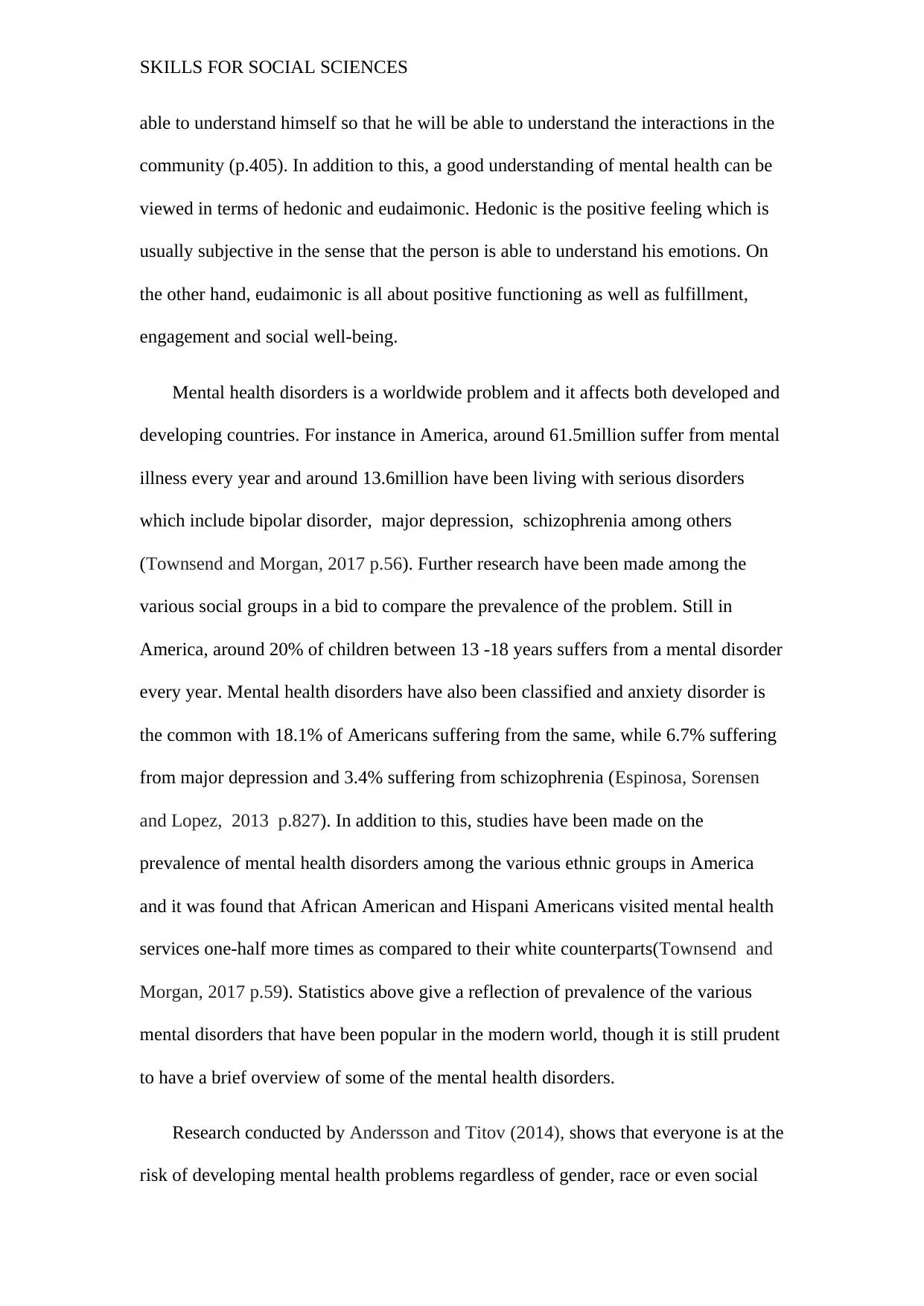
SKILLS FOR SOCIAL SCIENCES
able to understand himself so that he will be able to understand the interactions in the
community (p.405). In addition to this, a good understanding of mental health can be
viewed in terms of hedonic and eudaimonic. Hedonic is the positive feeling which is
usually subjective in the sense that the person is able to understand his emotions. On
the other hand, eudaimonic is all about positive functioning as well as fulfillment,
engagement and social well-being.
Mental health disorders is a worldwide problem and it affects both developed and
developing countries. For instance in America, around 61.5million suffer from mental
illness every year and around 13.6million have been living with serious disorders
which include bipolar disorder, major depression, schizophrenia among others
(Townsend and Morgan, 2017 p.56). Further research have been made among the
various social groups in a bid to compare the prevalence of the problem. Still in
America, around 20% of children between 13 -18 years suffers from a mental disorder
every year. Mental health disorders have also been classified and anxiety disorder is
the common with 18.1% of Americans suffering from the same, while 6.7% suffering
from major depression and 3.4% suffering from schizophrenia (Espinosa, Sorensen
and Lopez, 2013 p.827). In addition to this, studies have been made on the
prevalence of mental health disorders among the various ethnic groups in America
and it was found that African American and Hispani Americans visited mental health
services one-half more times as compared to their white counterparts(Townsend and
Morgan, 2017 p.59). Statistics above give a reflection of prevalence of the various
mental disorders that have been popular in the modern world, though it is still prudent
to have a brief overview of some of the mental health disorders.
Research conducted by Andersson and Titov (2014), shows that everyone is at the
risk of developing mental health problems regardless of gender, race or even social
able to understand himself so that he will be able to understand the interactions in the
community (p.405). In addition to this, a good understanding of mental health can be
viewed in terms of hedonic and eudaimonic. Hedonic is the positive feeling which is
usually subjective in the sense that the person is able to understand his emotions. On
the other hand, eudaimonic is all about positive functioning as well as fulfillment,
engagement and social well-being.
Mental health disorders is a worldwide problem and it affects both developed and
developing countries. For instance in America, around 61.5million suffer from mental
illness every year and around 13.6million have been living with serious disorders
which include bipolar disorder, major depression, schizophrenia among others
(Townsend and Morgan, 2017 p.56). Further research have been made among the
various social groups in a bid to compare the prevalence of the problem. Still in
America, around 20% of children between 13 -18 years suffers from a mental disorder
every year. Mental health disorders have also been classified and anxiety disorder is
the common with 18.1% of Americans suffering from the same, while 6.7% suffering
from major depression and 3.4% suffering from schizophrenia (Espinosa, Sorensen
and Lopez, 2013 p.827). In addition to this, studies have been made on the
prevalence of mental health disorders among the various ethnic groups in America
and it was found that African American and Hispani Americans visited mental health
services one-half more times as compared to their white counterparts(Townsend and
Morgan, 2017 p.59). Statistics above give a reflection of prevalence of the various
mental disorders that have been popular in the modern world, though it is still prudent
to have a brief overview of some of the mental health disorders.
Research conducted by Andersson and Titov (2014), shows that everyone is at the
risk of developing mental health problems regardless of gender, race or even social
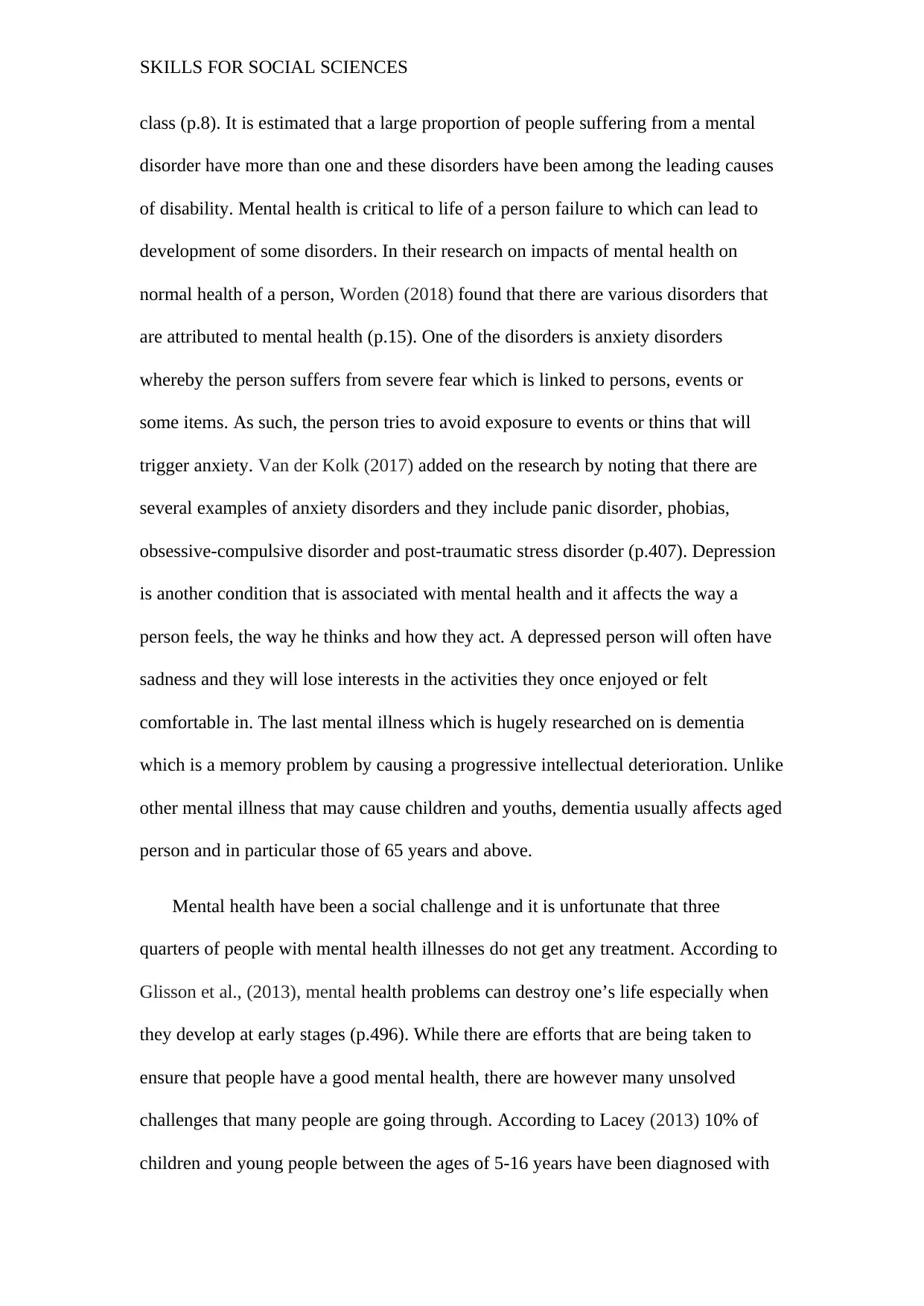
SKILLS FOR SOCIAL SCIENCES
class (p.8). It is estimated that a large proportion of people suffering from a mental
disorder have more than one and these disorders have been among the leading causes
of disability. Mental health is critical to life of a person failure to which can lead to
development of some disorders. In their research on impacts of mental health on
normal health of a person, Worden (2018) found that there are various disorders that
are attributed to mental health (p.15). One of the disorders is anxiety disorders
whereby the person suffers from severe fear which is linked to persons, events or
some items. As such, the person tries to avoid exposure to events or thins that will
trigger anxiety. Van der Kolk (2017) added on the research by noting that there are
several examples of anxiety disorders and they include panic disorder, phobias,
obsessive-compulsive disorder and post-traumatic stress disorder (p.407). Depression
is another condition that is associated with mental health and it affects the way a
person feels, the way he thinks and how they act. A depressed person will often have
sadness and they will lose interests in the activities they once enjoyed or felt
comfortable in. The last mental illness which is hugely researched on is dementia
which is a memory problem by causing a progressive intellectual deterioration. Unlike
other mental illness that may cause children and youths, dementia usually affects aged
person and in particular those of 65 years and above.
Mental health have been a social challenge and it is unfortunate that three
quarters of people with mental health illnesses do not get any treatment. According to
Glisson et al., (2013), mental health problems can destroy one’s life especially when
they develop at early stages (p.496). While there are efforts that are being taken to
ensure that people have a good mental health, there are however many unsolved
challenges that many people are going through. According to Lacey (2013) 10% of
children and young people between the ages of 5-16 years have been diagnosed with
class (p.8). It is estimated that a large proportion of people suffering from a mental
disorder have more than one and these disorders have been among the leading causes
of disability. Mental health is critical to life of a person failure to which can lead to
development of some disorders. In their research on impacts of mental health on
normal health of a person, Worden (2018) found that there are various disorders that
are attributed to mental health (p.15). One of the disorders is anxiety disorders
whereby the person suffers from severe fear which is linked to persons, events or
some items. As such, the person tries to avoid exposure to events or thins that will
trigger anxiety. Van der Kolk (2017) added on the research by noting that there are
several examples of anxiety disorders and they include panic disorder, phobias,
obsessive-compulsive disorder and post-traumatic stress disorder (p.407). Depression
is another condition that is associated with mental health and it affects the way a
person feels, the way he thinks and how they act. A depressed person will often have
sadness and they will lose interests in the activities they once enjoyed or felt
comfortable in. The last mental illness which is hugely researched on is dementia
which is a memory problem by causing a progressive intellectual deterioration. Unlike
other mental illness that may cause children and youths, dementia usually affects aged
person and in particular those of 65 years and above.
Mental health have been a social challenge and it is unfortunate that three
quarters of people with mental health illnesses do not get any treatment. According to
Glisson et al., (2013), mental health problems can destroy one’s life especially when
they develop at early stages (p.496). While there are efforts that are being taken to
ensure that people have a good mental health, there are however many unsolved
challenges that many people are going through. According to Lacey (2013) 10% of
children and young people between the ages of 5-16 years have been diagnosed with
⊘ This is a preview!⊘
Do you want full access?
Subscribe today to unlock all pages.

Trusted by 1+ million students worldwide
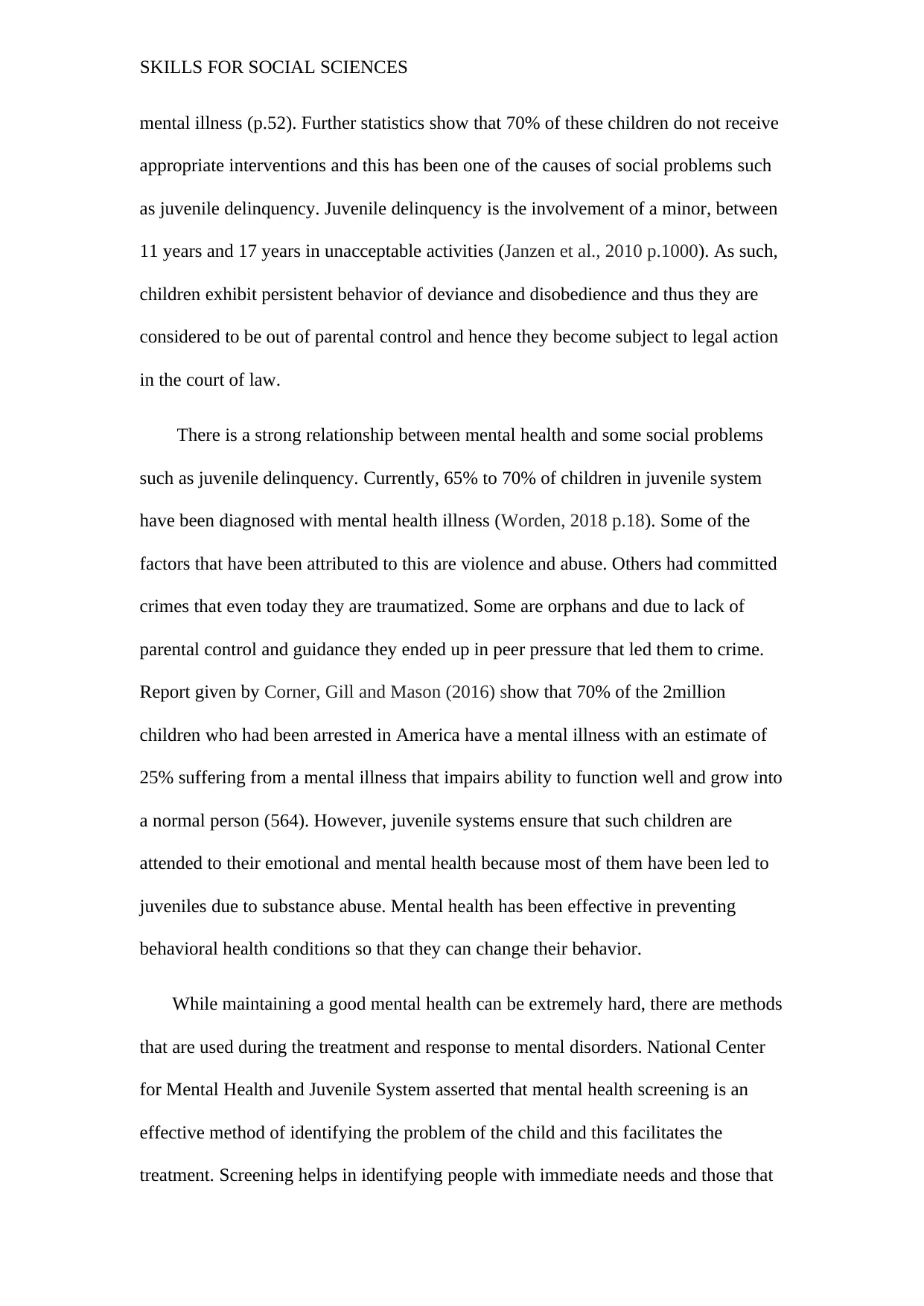
SKILLS FOR SOCIAL SCIENCES
mental illness (p.52). Further statistics show that 70% of these children do not receive
appropriate interventions and this has been one of the causes of social problems such
as juvenile delinquency. Juvenile delinquency is the involvement of a minor, between
11 years and 17 years in unacceptable activities (Janzen et al., 2010 p.1000). As such,
children exhibit persistent behavior of deviance and disobedience and thus they are
considered to be out of parental control and hence they become subject to legal action
in the court of law.
There is a strong relationship between mental health and some social problems
such as juvenile delinquency. Currently, 65% to 70% of children in juvenile system
have been diagnosed with mental health illness (Worden, 2018 p.18). Some of the
factors that have been attributed to this are violence and abuse. Others had committed
crimes that even today they are traumatized. Some are orphans and due to lack of
parental control and guidance they ended up in peer pressure that led them to crime.
Report given by Corner, Gill and Mason (2016) show that 70% of the 2million
children who had been arrested in America have a mental illness with an estimate of
25% suffering from a mental illness that impairs ability to function well and grow into
a normal person (564). However, juvenile systems ensure that such children are
attended to their emotional and mental health because most of them have been led to
juveniles due to substance abuse. Mental health has been effective in preventing
behavioral health conditions so that they can change their behavior.
While maintaining a good mental health can be extremely hard, there are methods
that are used during the treatment and response to mental disorders. National Center
for Mental Health and Juvenile System asserted that mental health screening is an
effective method of identifying the problem of the child and this facilitates the
treatment. Screening helps in identifying people with immediate needs and those that
mental illness (p.52). Further statistics show that 70% of these children do not receive
appropriate interventions and this has been one of the causes of social problems such
as juvenile delinquency. Juvenile delinquency is the involvement of a minor, between
11 years and 17 years in unacceptable activities (Janzen et al., 2010 p.1000). As such,
children exhibit persistent behavior of deviance and disobedience and thus they are
considered to be out of parental control and hence they become subject to legal action
in the court of law.
There is a strong relationship between mental health and some social problems
such as juvenile delinquency. Currently, 65% to 70% of children in juvenile system
have been diagnosed with mental health illness (Worden, 2018 p.18). Some of the
factors that have been attributed to this are violence and abuse. Others had committed
crimes that even today they are traumatized. Some are orphans and due to lack of
parental control and guidance they ended up in peer pressure that led them to crime.
Report given by Corner, Gill and Mason (2016) show that 70% of the 2million
children who had been arrested in America have a mental illness with an estimate of
25% suffering from a mental illness that impairs ability to function well and grow into
a normal person (564). However, juvenile systems ensure that such children are
attended to their emotional and mental health because most of them have been led to
juveniles due to substance abuse. Mental health has been effective in preventing
behavioral health conditions so that they can change their behavior.
While maintaining a good mental health can be extremely hard, there are methods
that are used during the treatment and response to mental disorders. National Center
for Mental Health and Juvenile System asserted that mental health screening is an
effective method of identifying the problem of the child and this facilitates the
treatment. Screening helps in identifying people with immediate needs and those that
Paraphrase This Document
Need a fresh take? Get an instant paraphrase of this document with our AI Paraphraser
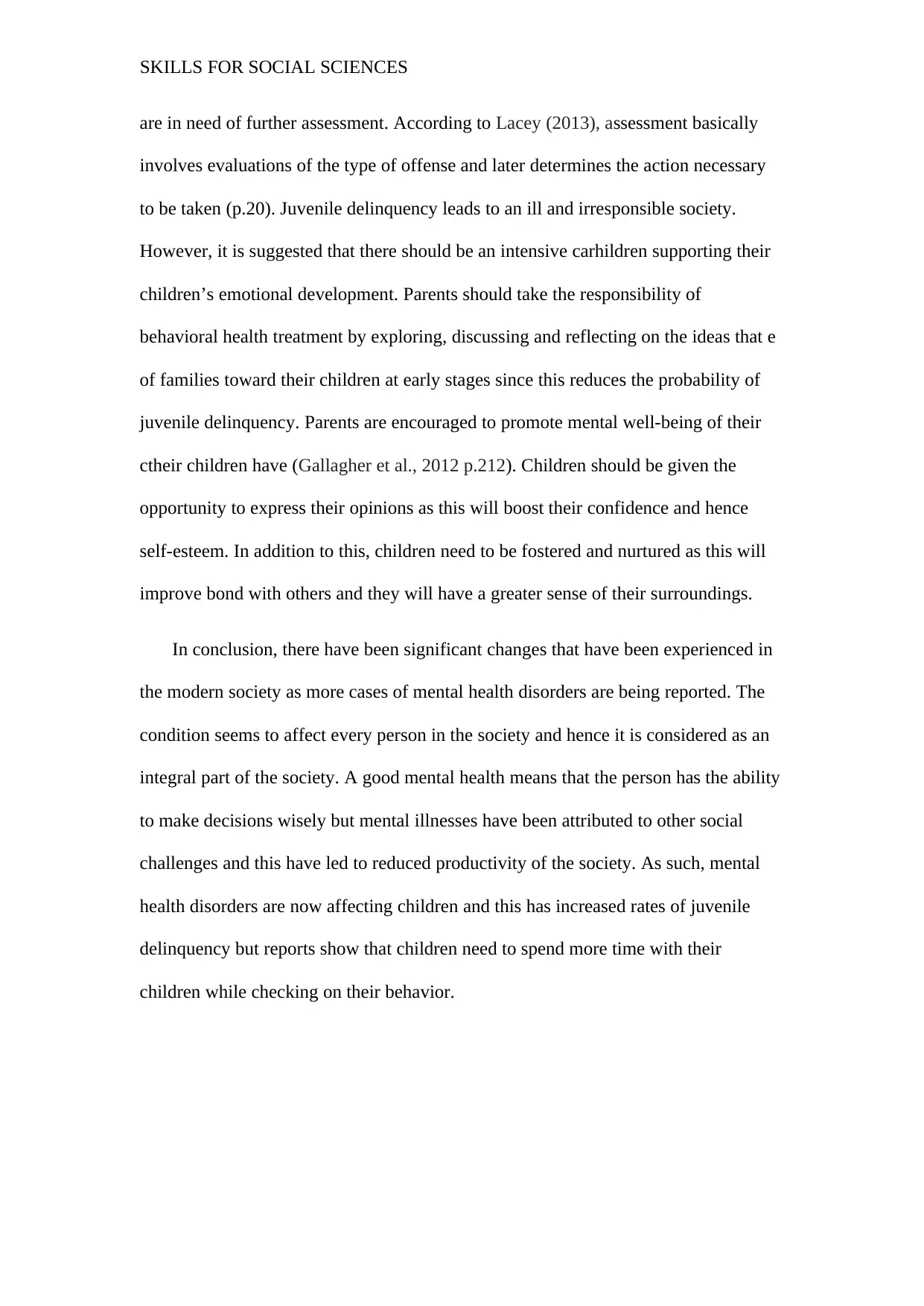
SKILLS FOR SOCIAL SCIENCES
are in need of further assessment. According to Lacey (2013), assessment basically
involves evaluations of the type of offense and later determines the action necessary
to be taken (p.20). Juvenile delinquency leads to an ill and irresponsible society.
However, it is suggested that there should be an intensive carhildren supporting their
children’s emotional development. Parents should take the responsibility of
behavioral health treatment by exploring, discussing and reflecting on the ideas that e
of families toward their children at early stages since this reduces the probability of
juvenile delinquency. Parents are encouraged to promote mental well-being of their
ctheir children have (Gallagher et al., 2012 p.212). Children should be given the
opportunity to express their opinions as this will boost their confidence and hence
self-esteem. In addition to this, children need to be fostered and nurtured as this will
improve bond with others and they will have a greater sense of their surroundings.
In conclusion, there have been significant changes that have been experienced in
the modern society as more cases of mental health disorders are being reported. The
condition seems to affect every person in the society and hence it is considered as an
integral part of the society. A good mental health means that the person has the ability
to make decisions wisely but mental illnesses have been attributed to other social
challenges and this have led to reduced productivity of the society. As such, mental
health disorders are now affecting children and this has increased rates of juvenile
delinquency but reports show that children need to spend more time with their
children while checking on their behavior.
are in need of further assessment. According to Lacey (2013), assessment basically
involves evaluations of the type of offense and later determines the action necessary
to be taken (p.20). Juvenile delinquency leads to an ill and irresponsible society.
However, it is suggested that there should be an intensive carhildren supporting their
children’s emotional development. Parents should take the responsibility of
behavioral health treatment by exploring, discussing and reflecting on the ideas that e
of families toward their children at early stages since this reduces the probability of
juvenile delinquency. Parents are encouraged to promote mental well-being of their
ctheir children have (Gallagher et al., 2012 p.212). Children should be given the
opportunity to express their opinions as this will boost their confidence and hence
self-esteem. In addition to this, children need to be fostered and nurtured as this will
improve bond with others and they will have a greater sense of their surroundings.
In conclusion, there have been significant changes that have been experienced in
the modern society as more cases of mental health disorders are being reported. The
condition seems to affect every person in the society and hence it is considered as an
integral part of the society. A good mental health means that the person has the ability
to make decisions wisely but mental illnesses have been attributed to other social
challenges and this have led to reduced productivity of the society. As such, mental
health disorders are now affecting children and this has increased rates of juvenile
delinquency but reports show that children need to spend more time with their
children while checking on their behavior.

SKILLS FOR SOCIAL SCIENCES
\
\
⊘ This is a preview!⊘
Do you want full access?
Subscribe today to unlock all pages.

Trusted by 1+ million students worldwide
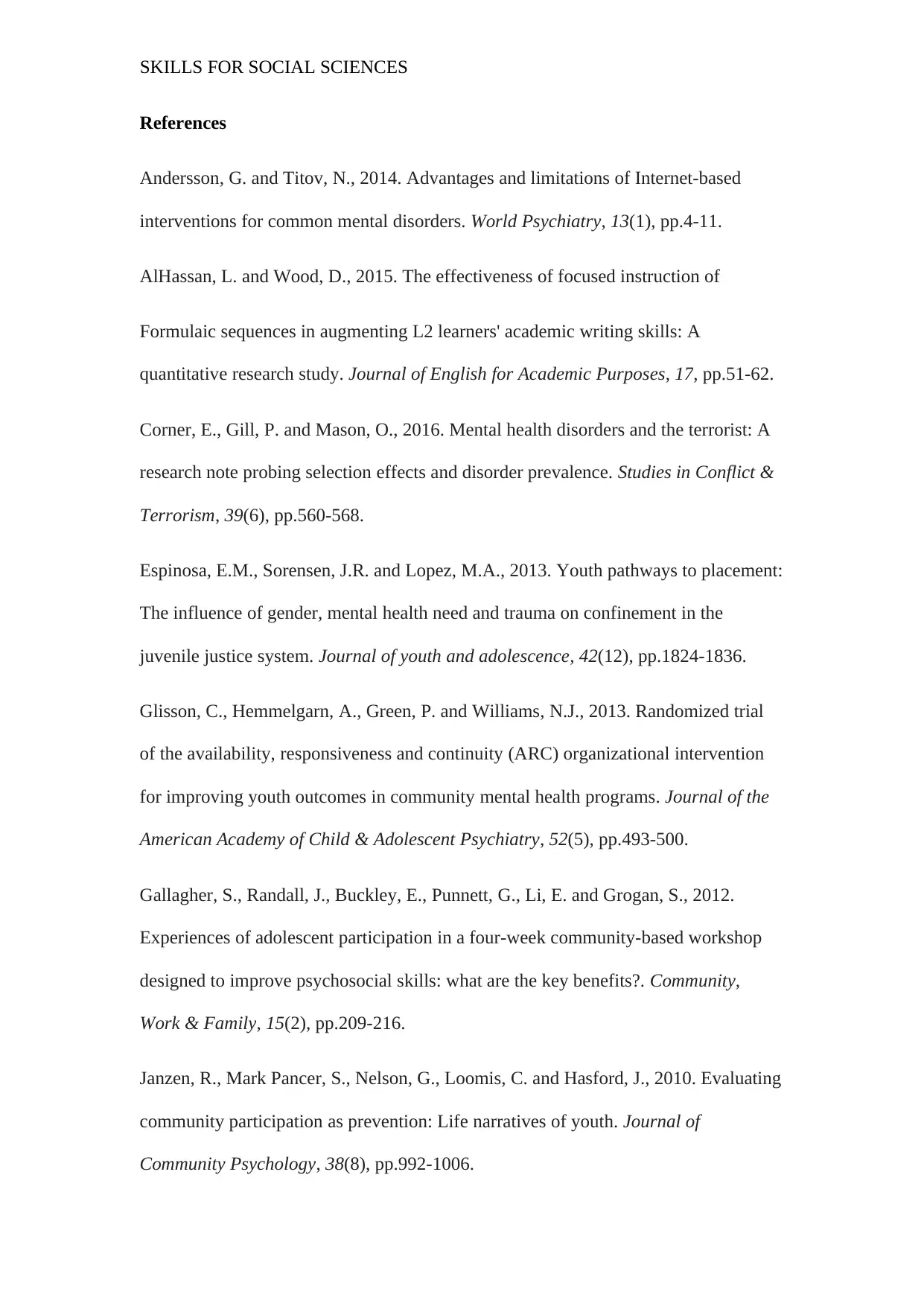
SKILLS FOR SOCIAL SCIENCES
References
Andersson, G. and Titov, N., 2014. Advantages and limitations of Internet‐based
interventions for common mental disorders. World Psychiatry, 13(1), pp.4-11.
AlHassan, L. and Wood, D., 2015. The effectiveness of focused instruction of
Formulaic sequences in augmenting L2 learners' academic writing skills: A
quantitative research study. Journal of English for Academic Purposes, 17, pp.51-62.
Corner, E., Gill, P. and Mason, O., 2016. Mental health disorders and the terrorist: A
research note probing selection effects and disorder prevalence. Studies in Conflict &
Terrorism, 39(6), pp.560-568.
Espinosa, E.M., Sorensen, J.R. and Lopez, M.A., 2013. Youth pathways to placement:
The influence of gender, mental health need and trauma on confinement in the
juvenile justice system. Journal of youth and adolescence, 42(12), pp.1824-1836.
Glisson, C., Hemmelgarn, A., Green, P. and Williams, N.J., 2013. Randomized trial
of the availability, responsiveness and continuity (ARC) organizational intervention
for improving youth outcomes in community mental health programs. Journal of the
American Academy of Child & Adolescent Psychiatry, 52(5), pp.493-500.
Gallagher, S., Randall, J., Buckley, E., Punnett, G., Li, E. and Grogan, S., 2012.
Experiences of adolescent participation in a four-week community-based workshop
designed to improve psychosocial skills: what are the key benefits?. Community,
Work & Family, 15(2), pp.209-216.
Janzen, R., Mark Pancer, S., Nelson, G., Loomis, C. and Hasford, J., 2010. Evaluating
community participation as prevention: Life narratives of youth. Journal of
Community Psychology, 38(8), pp.992-1006.
References
Andersson, G. and Titov, N., 2014. Advantages and limitations of Internet‐based
interventions for common mental disorders. World Psychiatry, 13(1), pp.4-11.
AlHassan, L. and Wood, D., 2015. The effectiveness of focused instruction of
Formulaic sequences in augmenting L2 learners' academic writing skills: A
quantitative research study. Journal of English for Academic Purposes, 17, pp.51-62.
Corner, E., Gill, P. and Mason, O., 2016. Mental health disorders and the terrorist: A
research note probing selection effects and disorder prevalence. Studies in Conflict &
Terrorism, 39(6), pp.560-568.
Espinosa, E.M., Sorensen, J.R. and Lopez, M.A., 2013. Youth pathways to placement:
The influence of gender, mental health need and trauma on confinement in the
juvenile justice system. Journal of youth and adolescence, 42(12), pp.1824-1836.
Glisson, C., Hemmelgarn, A., Green, P. and Williams, N.J., 2013. Randomized trial
of the availability, responsiveness and continuity (ARC) organizational intervention
for improving youth outcomes in community mental health programs. Journal of the
American Academy of Child & Adolescent Psychiatry, 52(5), pp.493-500.
Gallagher, S., Randall, J., Buckley, E., Punnett, G., Li, E. and Grogan, S., 2012.
Experiences of adolescent participation in a four-week community-based workshop
designed to improve psychosocial skills: what are the key benefits?. Community,
Work & Family, 15(2), pp.209-216.
Janzen, R., Mark Pancer, S., Nelson, G., Loomis, C. and Hasford, J., 2010. Evaluating
community participation as prevention: Life narratives of youth. Journal of
Community Psychology, 38(8), pp.992-1006.
Paraphrase This Document
Need a fresh take? Get an instant paraphrase of this document with our AI Paraphraser
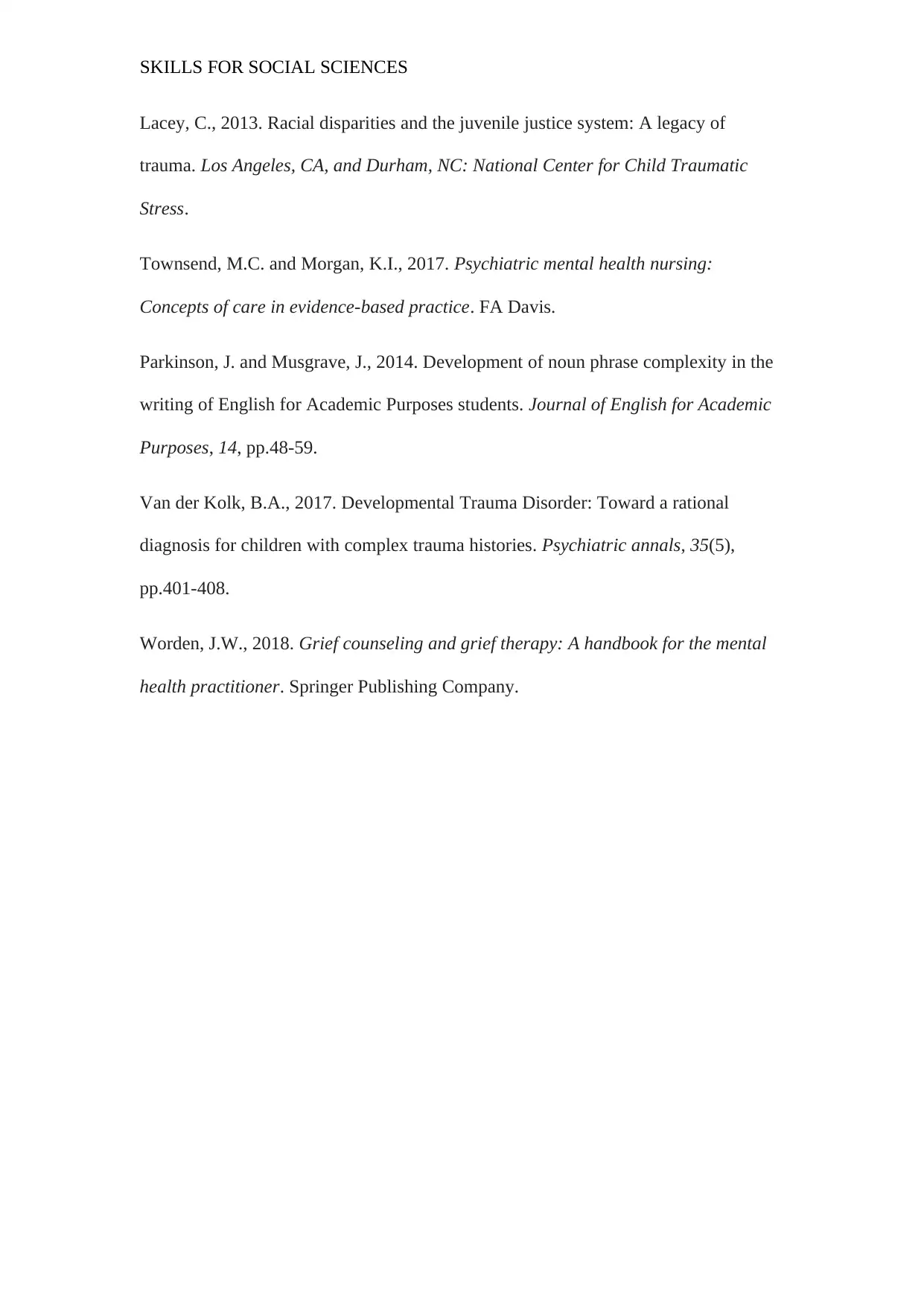
SKILLS FOR SOCIAL SCIENCES
Lacey, C., 2013. Racial disparities and the juvenile justice system: A legacy of
trauma. Los Angeles, CA, and Durham, NC: National Center for Child Traumatic
Stress.
Townsend, M.C. and Morgan, K.I., 2017. Psychiatric mental health nursing:
Concepts of care in evidence-based practice. FA Davis.
Parkinson, J. and Musgrave, J., 2014. Development of noun phrase complexity in the
writing of English for Academic Purposes students. Journal of English for Academic
Purposes, 14, pp.48-59.
Van der Kolk, B.A., 2017. Developmental Trauma Disorder: Toward a rational
diagnosis for children with complex trauma histories. Psychiatric annals, 35(5),
pp.401-408.
Worden, J.W., 2018. Grief counseling and grief therapy: A handbook for the mental
health practitioner. Springer Publishing Company.
Lacey, C., 2013. Racial disparities and the juvenile justice system: A legacy of
trauma. Los Angeles, CA, and Durham, NC: National Center for Child Traumatic
Stress.
Townsend, M.C. and Morgan, K.I., 2017. Psychiatric mental health nursing:
Concepts of care in evidence-based practice. FA Davis.
Parkinson, J. and Musgrave, J., 2014. Development of noun phrase complexity in the
writing of English for Academic Purposes students. Journal of English for Academic
Purposes, 14, pp.48-59.
Van der Kolk, B.A., 2017. Developmental Trauma Disorder: Toward a rational
diagnosis for children with complex trauma histories. Psychiatric annals, 35(5),
pp.401-408.
Worden, J.W., 2018. Grief counseling and grief therapy: A handbook for the mental
health practitioner. Springer Publishing Company.
1 out of 11
Related Documents
Your All-in-One AI-Powered Toolkit for Academic Success.
+13062052269
info@desklib.com
Available 24*7 on WhatsApp / Email
![[object Object]](/_next/static/media/star-bottom.7253800d.svg)
Unlock your academic potential
Copyright © 2020–2025 A2Z Services. All Rights Reserved. Developed and managed by ZUCOL.





